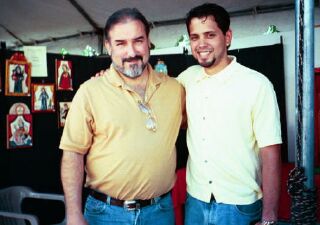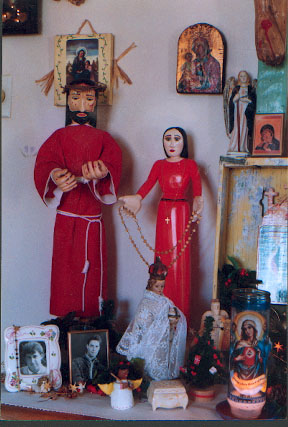 Charlie Carrillo and me on The 50th Spanish Market in Santa Fe, NM
Charlie Carrillo and me on The 50th Spanish Market in Santa Fe, NM
|
Welcome to My Santos Web Page!
Hello!
My name is Doel Augusto. I am a Puerto Rican Santero (Saint Maker) living the American Dream. I started carving in 2000. I used to go every other year to a bi-annual Santero(Saint Maker)Contest celebrated in the Ponce Museum of Art in my hometown back in PR. One year,I decided to start carving santos as a way to preserve my culture and to keep in contact with my Puerto Rican and Catholic roots. I interviewed with Master Santeros like Charlie Carrillo, Domingo Orta and Pablo Rinaldi. I studied the style of Great historical santeros from PR and NM like Rafael Aragon, the Espada Group and the Caban Group. Then read a lot of books on the topic specially those written by Teodoro Vidal, Barbe Awalt and Paul Rhetts. Of course, I kept my hands on the knife and wood. Just trying to improve myself on every piece carved or painted. Now I feel confident enough to share my art and culture with you all.
Please feel free to look around my website and contact me if you have comments or suggestions!
A Collector's Vision of Puerto Rico
This is my favorite link ever!!!
|
What is a Santo de Palo?
Santos de palo, or "saints made of wood," are the carved wooden images representing the saints, holy figures and legends of popular Catholicism that can be found in Puerto Rico, New Mexico and many other countries.
The santos once lived inside humble houses in small towns and countryside. As objects of devotion, they were usually displayed in a prominent position in the home's main room, on a small altar or in a nicho.
For believers, santos are much more than images. They are objects imbued with a saint's spirit, which can be invoked through devotion and prayer. They are intermediaries between heaven and earth who can communicate with God on behalf of their devotees. Believers may ask a saint to help cure an illness, bring consolation for a loss, avert a disaster, or otherwise provide for the physical and psychological well-being of themselves and their loved ones. A saint's power arises from his or her ability to perform requested favors or miracles. Devotees are responsible for keeping the saint satisfied through acts of devotion, and by acknowledging publicly any favor received.
The devotion to santos and the art of carving them was introduced into Puerto Rico and to large areas of South, Central and North America, the Caribbean, and the Philippines by the Spanish colonists. The creation and worship of santos became an integral part of life among the Spanish America's largely Catholic population.
|
 Home Shrine of my beloved friends Ana and Cirrus
Home Shrine of my beloved friends Ana and Cirrus
|
Home Shrines / Altares en los Hogares
The devotion to saints on home altars, by a family or a group of neighbors, helped answer a community's spiritual and psychological needs, particularly in the central part of the island, where churches were scarce. Small towns often had one patron saint, although everybody was aware of the miracle-making abilities of the various santos in their neighbors' homes.
The santos were often arranged in hierarchical order, with the crucifix and Virgin Mary occupying a central position and saints, such as Saint Anthony of Padua or Saint Lucy, and an archangel, like Saint Gabriel, arrayed around them.
Today, the santos de palo have surpassed their role as rustic, religious images to become positive symbols of a rich cultural heritage and identity.
There has been a renewed interest in the art. Some believe that this craft has become yet another tradition tainted by commercialism. I believe that even the most contemporary santero is inspired by the same religious fervor as earlier santeros.
|
|